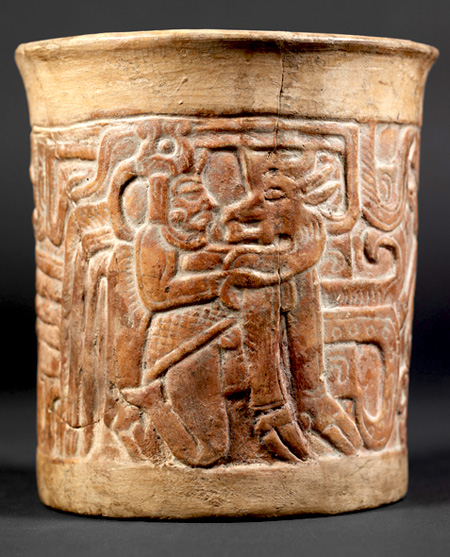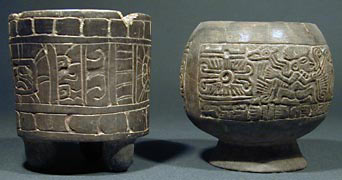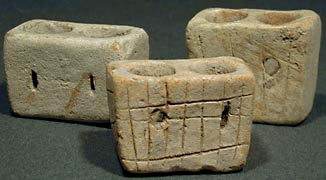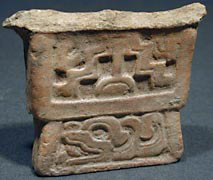The nature and degree of Teotihuacan influence on the art of the Tiquisate region has been downplayed by scholars for decades. The same sort of thing happened during the reign of the Carnegie Institution of Washington. Archaeologists in that era (the 1940's into the 1960's) would never accept Olmec influence on the development of Maya civilization and were rather blind to influence of Teotihuacan during the Early Classic. Only in recent years, now that the obvious Teotihuacan influence is so clear at Copan, has this subject been reopened. Nonetheless, the "official" maps of pre-Columbian Mesoamerica picture Teotihuacan influence jumping from Teotihuacan to Kaminaljuyu, and from there to Tikal and Copan, with virtually no intermediate stops.
 |
|
Vaso Hombre Venado, Museo Casa Santo Domingo Coleccion MAYAP.
|
The Teotihuacan presence throughout the Dept of Escuintla does get minor play in standard textbooks, but these books rarely picture an adequate sample of previously unpublished Teotihuacan material from Guatemala. The main emphasis are Mounds A and B of Kaminaljuyu or the few Teotihuacanoid items at Tikal.
The FLAAR Photo Archive has worked for over two decades to rewrite the actual history of Guatemala's illustrious Early Classic. We have found and photographed an unexpected quantity and quality of Teotihuacan-related artifacts. We have seen even more ceramic art but no archaeologist's budget allows photography of absolutely everything. We do the best with the limited funding available.
 |
|---|
Several years ago FLAAR prepared an illustrated inventory of the cylindrical tripods that we had photographed from 1970 through about 1992. In 1997 it was possible to accomplish direct-digital rollout photographs of about 90% of the Tiquisate cylindrical tripods in the extensive collections of the Museo Popol Vuh.
In 1999, we saw and photographed half as many Tiquisate pots as we photographed in the previous two decades. In other words, the inventory of Tiquisate pottery of 1992 is sort of obsolete.
Pictured at the left are two pots. The cylindrical tripod with rounded supports is the common small-sized cylindrical tripod. The standard motif is a RE glyph. The decoration is roughly gouged and incised, not mold-impressed. The color tends to be gray.
The globular pot with the pedestal base is a rarer shape. The same design as appears on this pot is more commonly seen on slab-footed cylindrical tripods. Slab-supports are rectangular, as opposed to the rounded supports. Pots with slab-supports tend to be mold-impressed, or at least carved to appear as though they are moldmade. Pedestal-based pots are also alternatives to cylindrical tripods throughout the same time period in the Central Peten.
The scene on the pedestal-based pot is typical of Tiquisate and has little traditional features from Teotihuacan. By no means are all Early Classic Tiquisate pots local imatations of Teotihuacan themes. The design on the globular vessel here is similar to motifs found on roller-stamps. The globular form (not considering the pedestal base) is a possible forerunner to the hemispherical bowls of the subsequent Tepeu times throughout the Peten.
All the pre-Columbian art pictured here is on exhibit in the hotel Posada Belen, downtown Guatemala City.
 |
|---|
Due to the unexpected quantity of material from Tiquisate, it will take years to process the abundant photographic material, but here at least we can show a few samples. Keep in mind this project is entirely archaeological and art historical. This is not a search for fancy pots to glorify. The photography is fortunately not devoted to hyping these pots to inflate their sales value. This is a round-about way of saying that these are real pre-Columbian artifacts, not slick pastiches recreated by self-claimed restorers. In other words, these artifacts may not always win an award for aesthetic quality, but they are of the utmost importance for analysis of pre-Columbian culture of ancient Guatemala.
 |
|---|
Hundreds of decorated supports of Tiquisate cylindrical tripods are available to study in the museums and collections worldwide. I would not be surprised if several hundred such supports could be found in Guatemala alone.
Because such supports are widely dispersed, it is a major undertaking to find and photograph even a sample. So far I have photographed at least 10% of the ones that are easy to locate. Here is an example of a recent find, in the informative study collection of the Posada Belen, Guatemala City. This is a fully registered collection and is on exhibit in the museum within this small hotel in downtown Guatemala City.
 |
|
The Tiquisate-type ceramic is the most frequent in the South Coast, it is best known for their decorative techniques, which are punched, incised, grooved, embossed, molded, carved and painted. |
 |
|
Most representations the Tiquisate-type ceramic appear with feathered headdresses and sometimes associated with other elements of the flora and fauna. The animals that most appear associated with those characters are monkeys, jaguars, birds, deers and snakes with feather headdresses.
|
Volunteer opportunities to study Maya iconography directly with ancient Maya art in Guatemalan museums
Complete directory of all Maya archaeology page links































